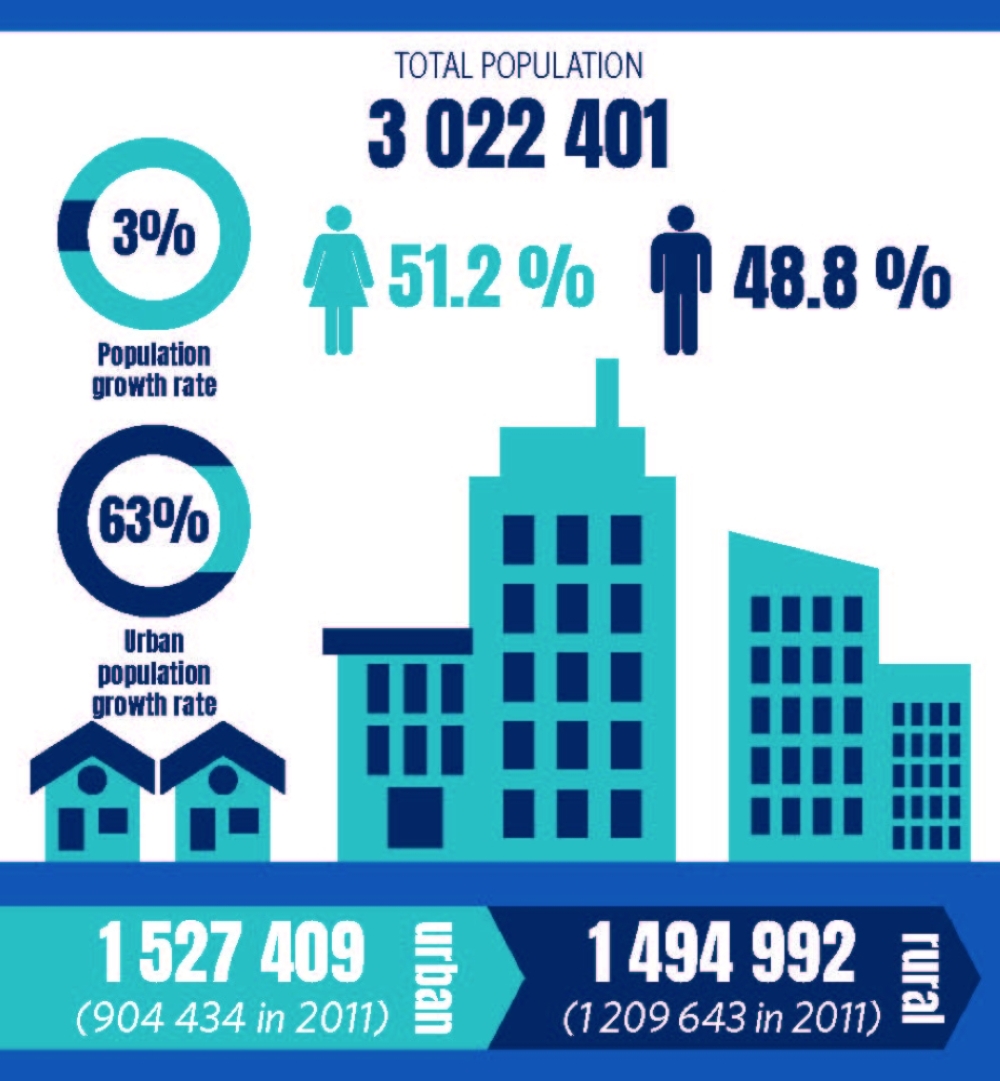Namibia’s population grows by 114% in 32 years
Khomas population nears half-million mark
The Kavango East, Zambezi and Erongo regions contributed significantly to the exponential growth, while women outnumber men in the country.
Namibia’s population has grown by more than 100% since independence, while its urban population growth is set to outpace rural population growth in the ensuing years.
This follows the release of preliminary census figures by statistician-general Alex Shimuafeni yesterday, which showed that the total population now stands at 3 022 401, which marks a 114.4% increase over a period of 32 years.
“We have hit the three-million mark. In 1991, we were 1.4 million, and then we were 1.8 million in 2001. In 2011, we were 2.1 million, and now we are three million,” Shimuafeni said.
Delving into the latest census figures, he noted that the Kavango East Region witnessed significant population growth, recording a 59.6% increase, followed by Erongo - which witnessed a 59.3% growth rate - and Zambezi, whose population growth rate was recorded at 53.9%.
“Erongo grew - maybe that is expected because people flocked to the coast for jobs,” he said.
Urban population on the increase
The figures also show that the population in urban areas increased by 65.5% between the 2011 and 2023 census, while those in rural areas increased by 26.3% between the two census years. Similarly, the difference in the urban and rural populations is closing at a faster pace given that it stood at 25.3% in 2011, compared to 2.1% in 2023.
Meanwhile, there were more women than men in both urban and rural areas in 2023. Census results show that there are 1 548 177 women, compared to 1 474 224 men. The difference between men and women is similar to what was observed in 2011.
The trend is similar at regional level, except for the //Karas, Erongo, Hardap, Kunene and Otjozondjupa regions, which recorded slightly more men than women. Similarly, a significant number of men (52.8%) were recorded in Omaheke compared to women (47.2%).
A massive 71.1% of Namibia’s population was under the age of 35. Moreover, 37% of the population were in the 0 to 14 age band, 34.1% in the 15 to 34 age band and 56.1% in the 15 to 59 age band, while 6.8% of the population were in the 60 and beyond age band.
Commenting on the youth demographic, Shimuafeni said there is no need to worry about a future workforce for Namibia.
“For the political principals, we have people to run the country going forward,” he said.
The number of households stood at 756 339, marking a 62.7% increase since the 2011 census when only 464 839 were recorded.
On average, there were 3.8 persons per household in 2023. This marks a decrease compared to the 4.4 persons per household recorded in 2011.
Population breakdown per region
The Ohangwena Region was noted as the most densely populated area with an average of 31.5 persons per square metre, followed by Oshana with 26.7 persons per square metre.
On the other hand, //Karas was recorded as the most sparsely populated region, with a population density of 0.7 persons per square metre.
A regional breakdown shows that Khomas has the highest population by region, with its inhabitants totalling 494 605, while Omaheke has the lowest population per region - 102 881.
The Ohangwena Region has the second-highest population totalling 337 729 inhabitants, followed by Omusati in third, with a population base of 316 671.
Oshikoto’s 257 302 inhabitants placed it in fourth, while Erongo and Oshana came in fifth and sixth with 240 206 and 230 801 inhabitants respectively.
The region with the seventh-highest population is Otjozondjupa, with 220 811.
Completing the bottom half of the regions is Kavango East with 218 421 inhabitants, Zambezi with 142 373, Kavango West with 123 226, //Karas with 109 898, Kunene with 120 762 and Hardap with 106 680.
The finalised census report is expected to be released in October 2025, along with a labour force report.
This follows the release of preliminary census figures by statistician-general Alex Shimuafeni yesterday, which showed that the total population now stands at 3 022 401, which marks a 114.4% increase over a period of 32 years.
“We have hit the three-million mark. In 1991, we were 1.4 million, and then we were 1.8 million in 2001. In 2011, we were 2.1 million, and now we are three million,” Shimuafeni said.
Delving into the latest census figures, he noted that the Kavango East Region witnessed significant population growth, recording a 59.6% increase, followed by Erongo - which witnessed a 59.3% growth rate - and Zambezi, whose population growth rate was recorded at 53.9%.
“Erongo grew - maybe that is expected because people flocked to the coast for jobs,” he said.
Urban population on the increase
The figures also show that the population in urban areas increased by 65.5% between the 2011 and 2023 census, while those in rural areas increased by 26.3% between the two census years. Similarly, the difference in the urban and rural populations is closing at a faster pace given that it stood at 25.3% in 2011, compared to 2.1% in 2023.
Meanwhile, there were more women than men in both urban and rural areas in 2023. Census results show that there are 1 548 177 women, compared to 1 474 224 men. The difference between men and women is similar to what was observed in 2011.
The trend is similar at regional level, except for the //Karas, Erongo, Hardap, Kunene and Otjozondjupa regions, which recorded slightly more men than women. Similarly, a significant number of men (52.8%) were recorded in Omaheke compared to women (47.2%).
A massive 71.1% of Namibia’s population was under the age of 35. Moreover, 37% of the population were in the 0 to 14 age band, 34.1% in the 15 to 34 age band and 56.1% in the 15 to 59 age band, while 6.8% of the population were in the 60 and beyond age band.
Commenting on the youth demographic, Shimuafeni said there is no need to worry about a future workforce for Namibia.
“For the political principals, we have people to run the country going forward,” he said.
The number of households stood at 756 339, marking a 62.7% increase since the 2011 census when only 464 839 were recorded.
On average, there were 3.8 persons per household in 2023. This marks a decrease compared to the 4.4 persons per household recorded in 2011.
Population breakdown per region
The Ohangwena Region was noted as the most densely populated area with an average of 31.5 persons per square metre, followed by Oshana with 26.7 persons per square metre.
On the other hand, //Karas was recorded as the most sparsely populated region, with a population density of 0.7 persons per square metre.
A regional breakdown shows that Khomas has the highest population by region, with its inhabitants totalling 494 605, while Omaheke has the lowest population per region - 102 881.
The Ohangwena Region has the second-highest population totalling 337 729 inhabitants, followed by Omusati in third, with a population base of 316 671.
Oshikoto’s 257 302 inhabitants placed it in fourth, while Erongo and Oshana came in fifth and sixth with 240 206 and 230 801 inhabitants respectively.
The region with the seventh-highest population is Otjozondjupa, with 220 811.
Completing the bottom half of the regions is Kavango East with 218 421 inhabitants, Zambezi with 142 373, Kavango West with 123 226, //Karas with 109 898, Kunene with 120 762 and Hardap with 106 680.
The finalised census report is expected to be released in October 2025, along with a labour force report.






Comments